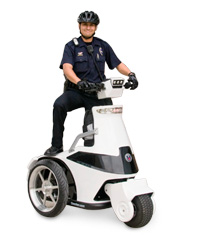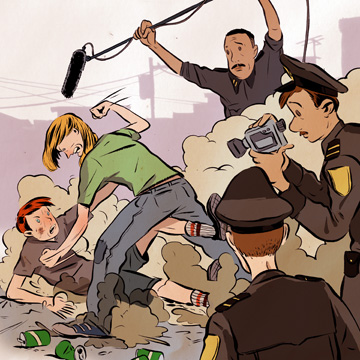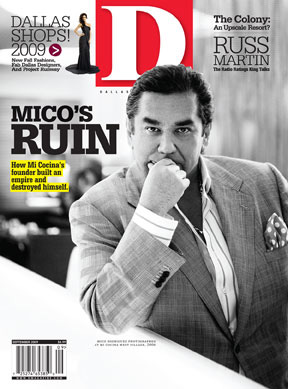Intemperate bar patrons loiter on a Lower Greenville sidewalk at 1:45 am on a recent Sunday. A knot forms in a group of about 100 people. They surge together then quickly fall back as if rocked by a small explosion. A fight has erupted.
The Dallas police officers standing on either side of me make eye contact with each other, shine a flashlight in the general direction of the trouble, and then head straight into the melee. Once they reach the center of the crowd, it’s several long moments before the combatants are subdued, handcuffed, and escorted to a nearby patrol car.
“It’s definitely more dangerous for us when it’s crowded like that,” says one of the cops with his Buffalo accent as he heads back to the other side of the street. But there’s little unique about the arrest they just made—except for the fact that this early- morning brawl was caught on videotape by the Dallas Police Department’s new camera crew. The camera isn’t there to stop a fight from breaking out. It isn’t intended to gather evidence for a potential trial, either. The department’s interest in cinematography arose as a way to cut down on crime by getting the truth out.
The program works like this: on two consecutive nights in June, a plainclothes video crew of officers accompanied uniformed cops through patrols in Deep Ellum and along Lower Greenville. It was the video crew’s job to tape the sights, sounds, and occasionally unlawful missteps of the Dallas bar crowd. Once that evidence is gathered, Deputy Chief Vince Golbeck says, the department can use the footage in meetings with club and bar owners to reinforce what his officers report seeing on a regular basis. In other words, he uses it to lobby the owners to change the way they do business if it’s causing a public safety problem.
It’s a tactic that Lower Greenville gadfly Avi Adelman has used for years—videotaping drunks who urinate in yards or cause fights. In Adelman’s case, though, he uses the footage to shame club owners. The police want to use it to show the clubs that they aren’t just responsible for what goes on inside their doors, but on the sidewalks and streets as well.
“It’s hard to discount what everybody sitting in the room sees on the flat-screen TV,” Golbeck says. “Again, that was the sole purpose of this: to just help with the dialogue and just be forthright with each other. We’re not here to shut any clubs down. We’re here to make sure the clubs are managed in a responsible manner, that everybody has a good time, everybody makes money, and everybody goes home safe at night.”
Officers know the bar owners aren’t solely to blame. They say the crowded sidewalks of Lower Greenville are in part a symptom of Dallas’ months-old smoking ban. Die-hard smokers migrate from sidewalk to bar stool and back again, making the sidewalks nearly as full as the bars that line the street. The more drunk people there are outside a club, the more likely a fight will break out. What can the bar owners do to control patrons? According to Kimberly Owens, Golbeck’s second in command, who was present throughout the filming, the owners can control what sort of customers they attract.
“They relax their dress code,” she says. “A lot of them will reduce drink prices considerably. There are a lot of different things that can culminate in that.”
And the video cameras can help combat this, but only if the bar owners have something at stake. Remember the tale of Deep Ellum. “In Deep Ellum’s case, there had been a lot of dialogue,” Golbeck says. “Then what it took was a city ordinance to hold these establishments more responsible. Sure enough, it did have an impact. And that’s where the specific use permits came into play. They knew their SUPs [granted by the city] would come up for renewal, or that they had to get an SUP. If they didn’t make any changes in the atmosphere or the behavior of the patrons of their club, then they had to suffer the consequences.”
On Saturday, the night before my trip to Lower Greenville, I followed the video crew as it shot footage in Deep Ellum. Everywhere we went, as soon as the camera started rolling, a nervous bouncer would come outside to talk with police and see what the “problem” was. It was clear that the bouncers’ polite interaction with police was motivated by fear—the fear of losing their special use permit.
Contrast that with the scene on Lower Greenville, where the bouncers could barely hear police over the music spilling out of clubs. Many of them aren’t worried about getting their SUP revoked because they don’t need one. About 10 establishments along Lower Greenville claim to be restaurants when they actually operate like a bar or club, Golbeck says. The City Attorney’s office and Code Compliance are actively auditing a number of these tenants to determine which category they fall into.
“Truly, if that was the same establishment in Deep Ellum, they would have to have an SUP,” Golbeck says. “They know that it’s very difficult or problematic to try to get an SUP for an alcoholic beverage establishment in Lower Greenville, because the neighborhoods don’t want anymore bars in there.”
Even though he believes videotaping these incidents helps responsible club owners make changes (and identifies irresponsible ones), Golbeck says he may not send the video crew out again this year. It depends on whether he thinks there are recurring problems. And though he can’t explicitly say so, he’s obviously hesitant to commit to a regular plan that includes gathering video footage because of the city’s budget woes.
“We have to be sensitive to the resources that it takes, because the [department’s AV staff] works from 8 am to 5 pm, and we are asking them to be out there at 2 o’clock in the morning,” Golbeck says. “We sure can’t use any overtime for it. We’ve got to be cognizant of that, respect that.”
Golbeck estimates that it cost the department less than $1,000 to gather footage during those two nights in June. Compare that to a recent DPD purchase of five new T3s—three-wheeled chariot-like devices similar to Segways—at about $8,000 apiece. That equals, at the very least, 40 nights of professional video surveillance.
Officers can’t say so on the record, but many would trade $40,000 in modern crime-fighting technology for the lower-tech solutions like video teams who can be used to turn routine bar fights and street-level drug deals into learning tools that helps make bar owners more responsible.
“Because a lot of times, property owners, they are not out there at 2 in the morning,” Owens says. “They don’t necessarily know what’s going on at 2 in the morning. But we can show them.”
Josh Hixson is a reporter for People Newspapers. Write to [email protected].

BANG FOR THE BUCK?
We know the gadget pictured right looks much better on a brochure or a recruiting video. But is it worth it?
cost of one night of video surveillance: $500
cost of one T3 crime-fighting tricycle: $8,000






